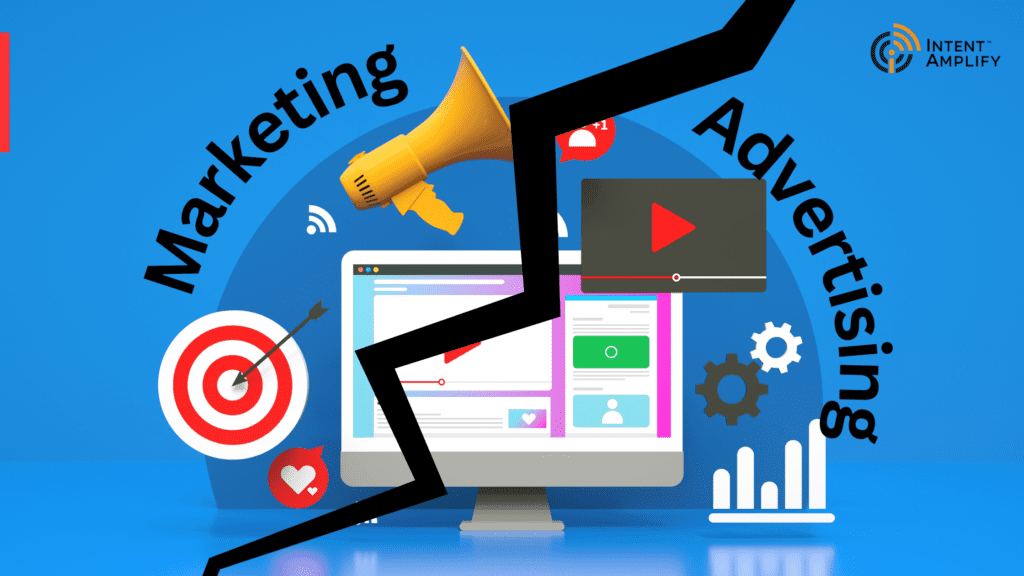
Decode the Dynamics: Difference Between Marketing & Advertising
Introduction:
The terms, marketing and advertising are frequently used concurrently. People often tend to get confused between these two terms. However, they actually refer to separate components of a comprehensive promotional approach.
It is crucial to comprehend the distinctions between marketing and advertising to create impact campaigns that yield favorable outcomes. To begin, it is important to establish clear definitions for each term. From there, we can delve into the practical advantages of each approach by examining real-world examples. Finally, we will analyze the key differences that set these two concepts apart.
What is Marketing?
Marketing is a comprehensive set of activities that are designed to promote products or services, establish connections with target audiences, and enhance brand recognition. The process of bringing a product/service to market entails a number of critical steps, including conducting thorough market research, pinpointing customer needs and preferences, developing the product itself, devising effective pricing strategies, establishing appropriate distribution channels, and implementing sound customer relationship management practices.
Marketing is a comprehensive strategy that assists businesses in generating value, building a market presence, and fostering customer loyalty.
Benefits Of Marketing

1) Targeted Approach:
Marketing is a powerful tool that enables businesses to identify and understand their target audience. By doing so, businesses can create tailored strategies that effectively reach and engage their intended audience.
2) Brand Building:
It is a crucial aspect of marketing that involves creating a unique identity that resonates with customers and fosters loyalty. Through various marketing efforts, businesses can cultivate brand recognition and differentiation, which helps to set them apart from their competitors. By establishing a strong brand identity, businesses can create a lasting impression on their target audience and build a loyal customer base.
3) Customer Engagement:
Marketing plays a crucial role in customer engagement by enabling businesses to manage their customer relationships effectively. This, in turn, helps to establish enduring connections with customers and foster loyalty, ultimately leading to repeat business.
4) Market Positioning:
Marketing plays a crucial role in helping businesses establish their market positioning as industry leaders. By effectively leveraging marketing strategies, businesses can influence consumer perceptions and gain a competitive edge in the market. This can ultimately lead to increased market share and greater success in the industry.
Real-Life Example
HubSpot, a prominent software platform for inbound marketing and sales, serves as a prime example of successful B2B marketing. Their marketing strategy is comprehensive. It covers content creation, SEO optimization, social media engagement, email marketing, and lead nurturing. HubSpot attracts B2B businesses by positioning itself as an industry authority. They nurture leads throughout the buyer’s journey by offering valuable resources, educational content, and thought leadership.
Salesforce is a highly acclaimed customer relationship management (CRM) platform that has established a reputation for its exceptional performance in B2B marketing. The company’s marketing strategy centers around informing and involving their intended audience through a range of platforms such as online seminars, informative documents, articles, and gatherings. Salesforce has successfully implemented account-based marketing (ABM) tactics to tailor their messaging and connect with important decision-makers within specific organizations. By doing so, they are able to emphasize the advantages of their customer relationship management (CRM) solution.
What is Advertising?
Advertising is a crucial part of marketing. It uses paid means to promote products, services, or brands. This is done across diverse channels. The main objective is to increase awareness. It aims to stimulate curiosity. It encourages the audience to take specific actions. These actions might include buying a product or exploring a website.
The art of advertising involves crafting imaginative messaging and captivating visuals that effectively capture the audience’s attention and convey persuasive brand communication.
Benefits Of Advertising

1) Enhanced Reach:
Advertising is a powerful tool that businesses can use to expand their market reach and attract new customers. By utilizing advertising, businesses can increase their reach and target a wider audience, ultimately leading to increased brand awareness and growth.
2) Brand Exposure:
Effective advertising campaigns can significantly enhance brand exposure, leaving a lasting impact on consumers and ensuring that the brand remains at the forefront of their minds.
3) Immediate Impact:
Advertising campaigns have the potential to yield immediate outcomes by stimulating sales and eliciting prompt reactions from intended audiences.
4) Competitive Differentiation:
In the world of marketing, it is crucial for brands to stand out from their competitors. This is where competitive differentiation comes into play. By effectively showcasing their unique selling points and competitive advantages, brands can set themselves apart and capture the attention of their target audience.
Advertising is a powerful tool that can be used to achieve this goal, as it allows brands to communicate their message and value proposition to potential customers. When done correctly, competitive differentiation can help brands establish a strong market position and drive business growth.
Real-Life Example
IBM, a renowned multinational technology corporation, has effectively leveraged advertising strategies to promote its B2B solutions. The company’s advertising initiatives frequently highlight practical use cases of their offerings, underscoring their ability to enhance operational effectiveness, tackle intricate challenges, and foster ingenuity for enterprises. IBM’s advertising campaigns utilize impactful imagery, captivating narratives, and data-backed communication to showcase their ability to provide significant benefits to enterprises spanning diverse sectors.
Cisco, a prominent provider of networking and technology solutions, has effectively reached its B2B audience through advertising. The networking solutions provider places emphasis on the transformative capabilities of their advertising campaigns, showcasing the positive effects on business growth, security, and collaboration. Cisco’s advertising campaigns frequently highlight relatable situations, demonstrating how their technology enables enterprises to flourish in an ever more interconnected global landscape.
Key Differences Between Marketing & Advertising:

1) Scope:
Marketing is a multibranched discipline that goes beyond mere advertising. It involves a plethora of activities such as conducting market research, developing products, determining pricing strategies, managing distribution channels, and fostering strong customer relationships.
On the other hand, advertising’s primary objective is to convey promotional messages through diverse channels.
2) Time-frame:
Marketing strategies cover the entire customer journey, starting from creating awareness to providing post-purchase support. They are comprehensive and long-term, aiming to achieve desired marketing objectives.
Advertising campaigns aim to achieve specific objectives within a short time frame. They focus on generating immediate impact. These campaigns are goal-oriented and target specific outcomes.
3) Channels:
Marketing employs a range of channels, such as advertising, public relations, content marketing, direct marketing, and others, in order to effectively connect with intended audiences.
On the other hand, advertising conveys promotional messaging through paid media channels and are the primary means of advertising.
4) Objective:
The primary objectives of marketing are centered around generating value for customers, fostering brand loyalty, establishing a strong market presence, and cultivating enduring customer relationships.
Whereas, the main goal of advertising is to increase brand recognition, stimulate curiosity, prompt immediate purchases or actions, and establish brand presence.
5) Focus:
Marketing is a comprehensive strategy that involves a thorough understanding of customer requirements, creating and refining products or services, and providing value at every stage of the customer experience.
On the other hand, the primary objective of advertising is to capture the attention of potential customers, convey brand messages effectively, and ultimately influence them to take a desired action.
Wrapping Up!
To put it simply, marketing encompasses all the efforts made to provide value to customers and establish relationships, while advertising is a specific component of marketing that concentrates on promoting products or services through paid channels. Marketing and advertising are crucial elements that form a fundamental part of any all-encompassing business strategy. To achieve long-term success for your business you must effectively leverage the unique roles of your team members. By doing so, you can maximize their impact and effectively reach their target audience.
If you are also looking for effective marketing or advertising of your brand, look no further. Intent Amplify has got you covered! Our team of in-house professionals assists you with effective and personalized strategies according to your needs and requirements.


